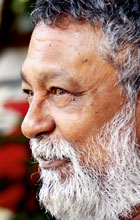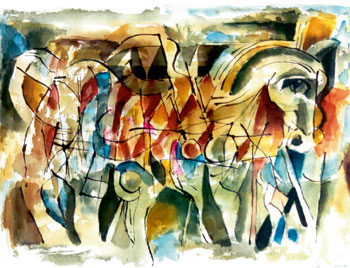Dressed in his regulation sarong and t-shirt, Laki Senanayake looks like there are few things he takes seriously – certainly, he doesn’t count his reputation as an ‘artist’ among them. “I’m assured by various people...that I’m Sri Lanka’s leading artist – God knows where I’m leading anyone,” he says, grinning.
We meet Laki at Barefoot, a day before his latest exhibition of sculptures and paintings will open to the public. We have the space to ourselves, and Laki gives us a personal tour, pointing out this painting or that and expounding on his theory of how anyone who can write can paint. Laki rarely stays on one subject for long – we also talk about the poor design of graphic tablets, a fellow flautist he recently made the acquaintance of, a house made of railway sleepers, how to keep elephants from bringing down a tree house, the challenges of transporting a 12 foot long ‘erotic’ sculpture and how hard it can be to keep one’s sarong paint and burn free. Laki is easy to like, more so because he is not one to stand on his own consequence. But don’t let that mislead you into thinking he doesn’t have any.
 |
| Laki at Barefoot: Pix by M.A. Pushpa Kumara |
He is simultaneously many things - painter, musician, sculptor, architect, landscape designer and inventor. His output is prolific and at any given time he will be juggling several projects. Scribbled in the margins of my notebook are his plans for a giant sculpture of a horse, with the roots of a 20 foot Nuga tree wound through its long, thin legs (“like Dali’s elephants”); the shape of a 12 foot high, 8 foot wide chandelier designed to mimic an upside down araliya tree, which will be highlighted in gold leaf and a rough sketch of his house of palms. The last has walls made out of the trunks of living trees and is wonderfully affordable to construct – Laki has been nurturing the trees for three years and seems confident they’ll last for at least another 97.
To judge Laki by his collaborators alone is also another interesting exercise – he has worked with designers like Ena de Silva and Barbara Sansoni, with leading architects like Valentine Gunasekara, Geoffrey Bawa and Ulrik Plesner, and the landscape designer Bevis Bawa, as well as thinkers and writers like Reggie Siriwardena and Kuru Gunawardena according to one biography. Interestingly, Laki still doesn’t seem altogether comfortable with even the most basic label – himself as an ‘artist’. “I will give you my theory of how to enjoy painting without being an artist,” he says, speaking of how as a young person he found himself convinced that a real painter had to produce work like Picasso.
“I knew you couldn’t copy them because that’s not original but that’s what your image of a good painting was...you’re always doing some derivative work. It took me so long to realise it didn’t matter where you derived your paintings from.” When the art teacher, Mrs. Cora Abraham told Laki he had ‘no style of his own’ and that he was ‘fractured’ she unintentionally liberated him. “I thought as long as I’m a ‘fractured’ artist I can do anything I want.” From early on, Laki found that the things he most liked to paint were trees, birds and animals and he was soon widely celebrated as a landscape painter. But you won’t find paintings in that precise, intricate style in this set. “I am known by most people as someone who does that kind of work, but most people who saw the paintings like Dom [Sansoni] and them have, would say, ‘no, that’s not you.’” Laughing he says, “It’s the secret me...”
Laki makes no pretences about his approach to painting – these are not fraught with symbolism or created in angst. Instead the first thing Laki worries about is wasting a perfectly good, expensive canvas. “It costs around 1000 rupees a sheet and if you mess that up, then you’re down Rs.1000. Now this is a major block,” he says, seriously. His way of working around that is to “take any old paint that is in the box and I throw it on the canvas and see what we can do from there.” Often he’ll use whatever colours are already on the palette so that the paint (also expensive) isn’t wasted.
He hops between paintings, letting each dry while he works on the next. They evolve under his brush and only rarely does he have anything specific planned. He then prices his paintings by how much he likes them – the more expensive are his favourites – or according to how much he needs for another project. If he doesn’t like a painting, he simply throws it away. And if they aren’t exhibited or snapped up by friends, he tends to stack them in a corner and forget about them. “They get eaten by silverfish, rats and white ants. Those I sell cheaply.” Really, it’s enough to make any self-respecting art collector want to keel over and die.
 |
The 40 odd paintings in this exhibition were painted mostly in Nairobi where Laki spent a month early this year. Pointing out ‘Kaleidoscope’ an abstract with geometric shapes in shades of purple, orange, blue, gray and green, he says the picture took him some work. In the end, it was while listening to a long time favourite - Italian composer Giancinto Scelsi - that he finally found his way through. “One interesting connection I have is with the music I listen to,” he says explaining that the chords and rhythms, the structure of the music and its interwoven patterns influence him deeply. It’s why he has paintings with titles like ‘Homage to Bach’ in his collection.
Another painting, a luscious nude, captures the beauty of a new tool. A porcupine quill allows Laki to draw exquisite natural lines that taper and bend with the human figure. “My invention is the best drawing instrument I’ve found,” he says, pointing out how it allows him to ‘inflect’ his lines. Standing back from the painting he tells me how he resents being told sometimes that his art comes so easily to him. “I’ve been drawing and painting and struggling with this whole thing for fifty years or something” – and his work continues to challenge him.
Despite the odd recalcitrant painting, Laki is clearly a dedicated artist, even if attending the launch of his exhibition isn’t something he’s entirely looking forward to. He left Dambulla at 3 a.m to be here. “I like to see my paintings, but when there’s a huge crowd of people....my face hurts with all that having to say hello and having to smile at people.” It’s why he’s likely to head straight back this same night to Dambulla and his refuge at Diyabubla, where there are dozen little projects awaiting his attention, foremost among which is a golden chandelier waiting to be strung up from his maara tree.
‘Laki’, an exhibition of the artist’s paintings and sculptures is on at Barefoot from June 10 – 26. |



